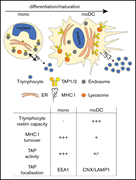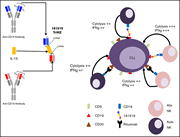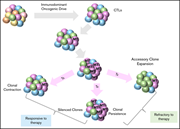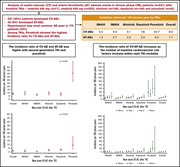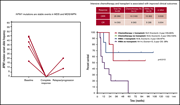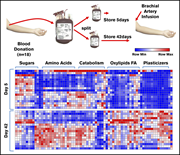Issue Archive
Table of Contents
STIMULUS REPORT
Effect of chronic opioid therapy on pain and survival in a humanized mouse model of sickle cell disease
The use of opioid analgesics in patients with sickle cell disease who develop painful crises is an unfortunate reality. Gupta and colleagues explore the impact of opioids on the survival of humanized mice with this disorder, resulting in important differences as compared to normal mice. Their findings could have significant clinical consequences.
IMMUNOBIOLOGY AND IMMUNOTHERAPY
Modulation of TAP-dependent antigen compartmentalization during human monocyte-to-DC differentiation
Novel CD19-targeted TriKE restores NK cell function and proliferative capacity in CLL
Trispecific killer engager (TriKE) molecules are engineered reagents that redirect specific immune cells, in this case natural killer cells, to engage target tumor cells more efficiently and effectively. Bachanova and colleagues explore the use of a CD19-directed TriKE in chronic lymphocytic leukemia (CLL) and demonstrate effective killing of primary CLL samples. Their findings set the stage for clinical translation.
LYMPHOID NEOPLASIA
MYELOID NEOPLASIA
Analysis of cardiovascular and arteriothrombotic adverse events in chronic-phase CML patients after frontline TKIs
Clinical Trials & Observations
Jain et al take on a major issue in the era of tyrosine kinase inhibitor (TKI) therapy for patients with chronic myeloid leukemia (CML). While these patients now have many options for targeted therapy, many are expensive, and they prominently include cardiovascular and arteriothrombotic adverse events. The authors systematically analyzed 531 CML patients treated with multiple TKIs in different trials. These included imatinib, nilotinib, dasatinib, and ponatinib. The authors found an increased risk of hypertension with all TKIs. Furthermore, when compared to imatinib dosed at 400 mg, there was an increased risk of cardiovascular events in CML patients with preexisting cardiovascular risk factors, and importantly, in those treated with second and third generation TKIs, particularly ponatinib. This study underscores the importance of vigilant assessment and management of cardiovascular comorbidities in all CML patients treated with TKIs.
Role of CYP3A4 in bone marrow microenvironment–mediated protection of FLT3/ITD AML from tyrosine kinase inhibitors
Jones et al address a critical issue in the field of FMS-like tyrosine kinase 3/internal tandem duplication–positive (FLT3/ITD+) leukemias, the fact that FLT3 inhibitors demonstrate superior activity against peripheral compared to bone marrow disease. They demonstrate that expression of cytochrome P450 enzymes (CYPs), in particular CYP3A4, play a major role in bone marrow stromal cell–mediated inhibition in the activity of several FLT3 inhibitors. Their findings suggest combining CYP inhibitors with FLT3 inhibitors may enhance clearance of bone marrow disease. These findings may have major implications for the treatment of FLT3+ acute myeloid leukemia.
NPM1 mutations define a specific subgroup of MDS and MDS/MPN patients with favorable outcomes with intensive chemotherapy
Clinical Trials & Observations
TRANSFUSION MEDICINE
Effects of aged stored autologous red blood cells on human plasma metabolome
Clinical Trials & Observations
The long-term storage of red blood cells has been an important development to broaden the blood pool and provide necessary products for patients. However, this storage may impact the stability and safety of the blood product. Gladwin and colleagues explored the metabolic effects on recipients of blood products from short vs long-term storage.
TRANSPLANTATION
Stem cell transplantation for osteopetrosis in patients beyond the age of 5 years
Clinical Trials & Observations
Stepensky et al take a major step forward in curative therapy for osteopetrosis, a rare but debilitating disorder. The infantile “malignant” form of osteopetrosis is severe enough to warrant bone marrow transplantation (BMT). Still, an increasing number of patients with less severe, “intermediate” forms of this disease are being diagnosed in the era of better understanding of the disease’s genetic causes. Stepensky et al’s findings open up a new therapeutic option, demonstrating that BMT with HLA-matched donors can be successfully performed in these patients. These patients demonstrate a significant improvement in symptoms and quality of life.
Plerixafor alone for the mobilization and transplantation of HLA-matched sibling donor hematopoietic stem cells
Clinical Trials & Observations
Mobilization of hematopoietic stem cells in normal donors is critically important for allogeneic transplantation and has typically been performed with granulocyte colony-stimulating factor (G-CSF). Although effective, this strategy has been associated with toxicities and takes several days for effective mobilization. Devine and colleagues present the use of plerixafor alone for mobilization of normal donors, demonstrating that this approach appears to be effective, less toxic, and more rapid than what is expected with G-CSF. If confirmed, this approach could change the practice of stem cell mobilization of normal donors.
ERRATUM
-
Cover Image
Cover Image
![issue cover]()
COVER FIGURE
Clustering of Raji cells and natural killer cells facilitated by the 161519 trispecific killer engager. See the article by Felices et al. - PDF Icon Front MatterFront Matter
- PDF Icon Editorial BoardEditorial Board
Advertisement intended for health care professionals
Advertisement intended for health care professionals


